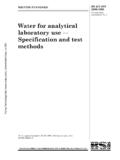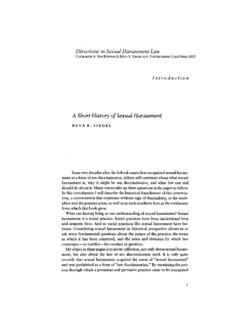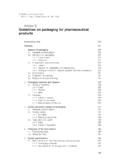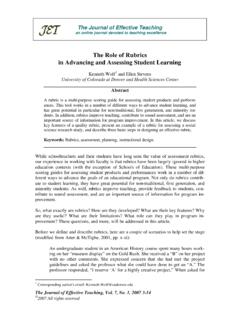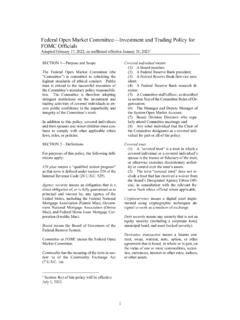Transcription of Standard Specification for Reagent Water
1 Designation: D 1193 99e1An American National StandardFederal Test MethodStandard No. 7916 Standard Specification forReagent Water1 This Standard is issued under the fixed designation D 1193; the number immediately following the designation indicates the year oforiginal adoption or, in the case of revision, the year of last revision. A number in parentheses indicates the year of last reapproval. Asuperscript epsilon (e) indicates an editorial change since the last revision or Standard has been approved for use by agencies of the Department of An editorial change was made in in October This specification covers requirements for Water suitablefor use in methods of chemical analysis and physical grades are specified:Type IType IIType IIIType IVElectrical conductivity,max, S/cm at 298 K(25 C) resistivity, min,MV cm at 298 K (25 C) at 298 K (25 C) to organic carbon(TOC), max, g/L5050200no limitSodium, max, g/L151050 Chlorides, max, g/L151050 Total silica, max, g/L33500no limitMicrobiological contamination When bacterial levels need to be controlled, Reagent grade types should be further classified as follows.
2 Type AType BType CMaximum heterotrophicbacteria count10/1000 mL 10/100 mL 100/10 mLEndotoxin, EU/mlB< appli-cableAThe measurement of pH in Type I, II, and III Reagent waters has beeneliminated from this specification because these grades of Water do not containconstituents in sufficient quantity to significantly alter the = Endotoxin The method of preparation of the various grades ofreagent Water determines the limits of impurities and shall beas Type I grade of Reagent Water shall be prepared bydistillation or other equal process, followed by polishing witha mixed bed of ion exchange materials and a m membranefilter. Feedwater to the final polishing step must have amaximum conductivity of 20 S/cm at 298K (25 C). Type II grade of Reagent Water shall be prepared bydistillation using a still designed to produce a distillate havinga conductivity of less than S/cm at 298 K (25 C).
3 Ionexchange, distillation, or reverse osmosis and organic adsorp-tion may be required prior to distillation if the purity cannot beattained by single Because distillation is a process commonly relied upon toproduce high purity Water , the levels specified for Type II Reagent waterwere selected to represent the minimum quality of Water that a distillationprocess should Type III grade of Reagent Water shall be prepared bydistillation, ion exchange, continuous electrodeionization re-verse osmosis, or a combination thereof, followed by polishingwith a m membrane Type IV grade of Reagent Water may be prepared bydistillation, ion exchange, continuous electrodeionization re-verse osmosis, electrodialysis, or a combination The choice of one of the various grades may bedesignated by the method or by the Standard does not purport to address all of thesafety concerns, if any, associated with its use.
4 It is theresponsibility of the user of this Standard to establish appro-priate safety and health practices and determine the applica-bility of regulatory limitations prior to Referenced Standards:D 1125 Test Methods for Electrical Conductivity and Re-sistivity of Water2D 1129 Terminology Relating to Water2D 1293 Test Methods for pH of Water2D 4453 Practice for Handling of Ultra-Pure Water Samples2D 4517 Test Method for Low-Level Total Silica in High-Purity Water by Flameless Atomic Absorption Spectros-copy3,4D 4779 Test Method for Total, Organic, and InorganicCarbon in High Purity Water by Ultraviolet (UV) orPersulfate Oxidation, or Both, and Infrared Detection4D 5391 Test Method for Electrical Conductivity and Resis-tivity of a Flowing High Purity Water Sample2D 5542 Test Method for Trace Anions in High Purity Waterby Ion Chromatography21 This specification is under the jurisdiction of ASTM Committee D-19 on Waterand is the responsibility of Subcommittee on General Specifications,Technical Resources, and Statistical edition approved Feb.
5 10, 1999. Published March 1999. Originally issuedas D 1193 51 T. Last previous edition D 1193 Book of ASTM Standards,Vol of Trace Silica in Industrial Process Waters by Flameless AtomicAbsorption Spectrometry, Judith Rawa and Earl Henn, Analytical Chemistry, Vol 51,No 3, March Book of ASTM Standards,Vol ASTM International, 100 Barr Harbor Drive, PO Box C700, West Conshohocken, PA 19428-2959, United 5997 Test Method for On-Line Monitoring of Total Car-bon, Inorganic Carbon in Water by Ultraviolet, PersulfateOxidation and Membrane Conductivity Detection2D 6071 Test Method for Low Level Sodium in High PurityWater by Graphite Furnace Atom Absorption Spectros-copy2F 1094 Test Methods for Microbiological Monitoring ofWater Used for Processing Electron and MicroelectronicDevices by Direct Pressure Tap Sampling Valve and by thePresterilized Plastic Bag Method53.
6 For definitions used in this specificationrefer to Terminology D Significance and Different analytical methods and industrial processesrequire Water of different purities. Also, different types ofcontaminants affect these methods and processes specification is intended to provide the user with a choiceof different grades of Water having different purities as de-scribed in Section 1. It is intended to satisfy the requirementsfor normal laboratory procedures, but does not necessarilyapply to the large-scale production of pure Water or for specificapplications. Different grades of Water may be covered byother ASTM specifications or guides, or by the requirements ofother standards Use and The method of preparing Type I Reagent Water may addorganic contaminants to the Water by contact with the ion-exchange materials.
7 It should be noted also that the methodmay or may not remove non-ionized dissolved The dissolved or particulate organic contaminationwould normally range from 30 to 50 g/L. The concentrationof nonionized dissolved gases may exceed 5 The quality of the effluent Water depends upon the type,age, and method of regeneration of the ion exchange , the flow rate through the ion exchange resin bed willchange the conductivity of the effluent Water . The instructionsof the manufacturer of the resins or the resin cartridge bedshould be The use of the membrane filter in the preparation ofType I and Type III Water may add a small amount of organiccomponents to the Water first Some membrane filters contain as much as 8 mass %of soluble components resulting from the manufacturing If the contamination of the Water by the organiccomponent is of significance to the test, Type II Water shouldbe used or the membrane should be rinsed by discarding thefirst 10 mL of Water produced per square centimetre of filterarea.
8 And until a test for the organic components shows them tohave been reduced to less than the specified Type II grade of Reagent Water should be sterile andpyrogen-free as produced and generally may be used wheneverfreedom from organic or biological contaminants is , the method of storage and handling of the Water mayitself result in Type II Water should be pyrogen-free, but must betested in conformance with the requirements of the currentedition of if proof is The description of Type II Reagent Water is intended tocharacterize the product of Distilled Water is often specified when freedom frommotes and silica is required, or when surface-active organicsare proven to be a problem, and when alternative processeshave been found to be Types I, II, and III Reagent Water should be protectedfrom atmospheric contamination and from solution of con-tainer and tubing Extreme care must be exercised in handling sampleswhen making an analysis.
9 Sample containers and tubing shouldbe made of fluorocarbon, titanium, tantalum, block tin, quartz,18-8 stainless steel, polyethylene, or other material proven tobe sufficiently resistant to chemical attack so as not to causecontamination in the intended use. Practice D 4453 should Because atmospheric gases and impurities rapidly re-contaminate exposed Water , in-line electrodes should be em-ployed for determining the electrical conductivity of reagentwater Types I, II, and III. The measurement of pH in Type I, II,and III Reagent waters has been eliminated from this specifi-cation because the values would be a function of the Since freedom from biological contaminants may beimportant in the test procedure using any of the Reagent watersspecified, a classification of bacterial levels is included andshould be specified if it is of significance to the test To obtain sterile Water , any of the types of reagentwater listed in this section may be produced, bottled, andheated to 394 K (121 C) for 20 min.
10 This procedure is mosteasily carried out by autoclaving at 103 kPa (15 psi) for following requirement is beyond the requirements ofthe general specifications:The use of Reagent grade watershould recognize that analytes may exist in Water that meets thecriteria listed in Section 1, but these analytes may interferewith the use of the Water . If levels of other analytes areimportant, it is the user s responsibility to specify their Reagent Water shall conform to the requirements speci-fied in Section Additional requirements concerning specific contami-nants or methods of preparation may be included in thisspecification by mutual agreement between the parties Test Conductivity and Resistivity Refer to TestMethods D 1125 and D Refer to Test Methods D Refer to Test Method D Book of ASTM Standards,Vol Refer to Test Methods D Refer to Test Method D Refer to Test Method D 4779 and D Refer to LAL Test Contamination Refer to Test MethodsF laboratory analysis; Reagent .
